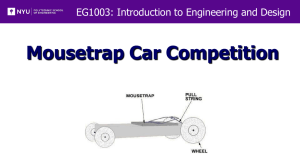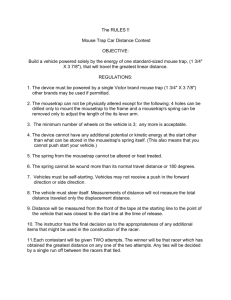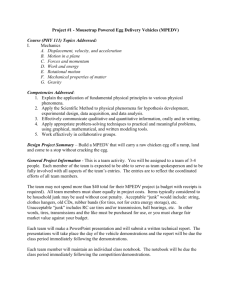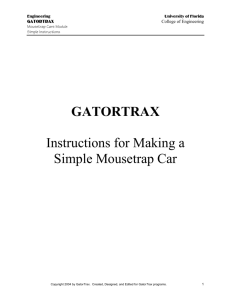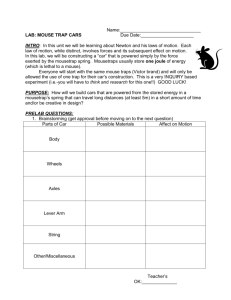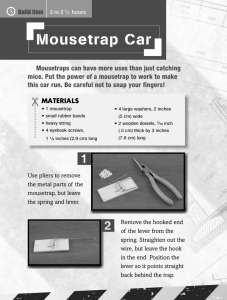GATORTRAX College of Engineering MOUSETRAP CARS The
advertisement
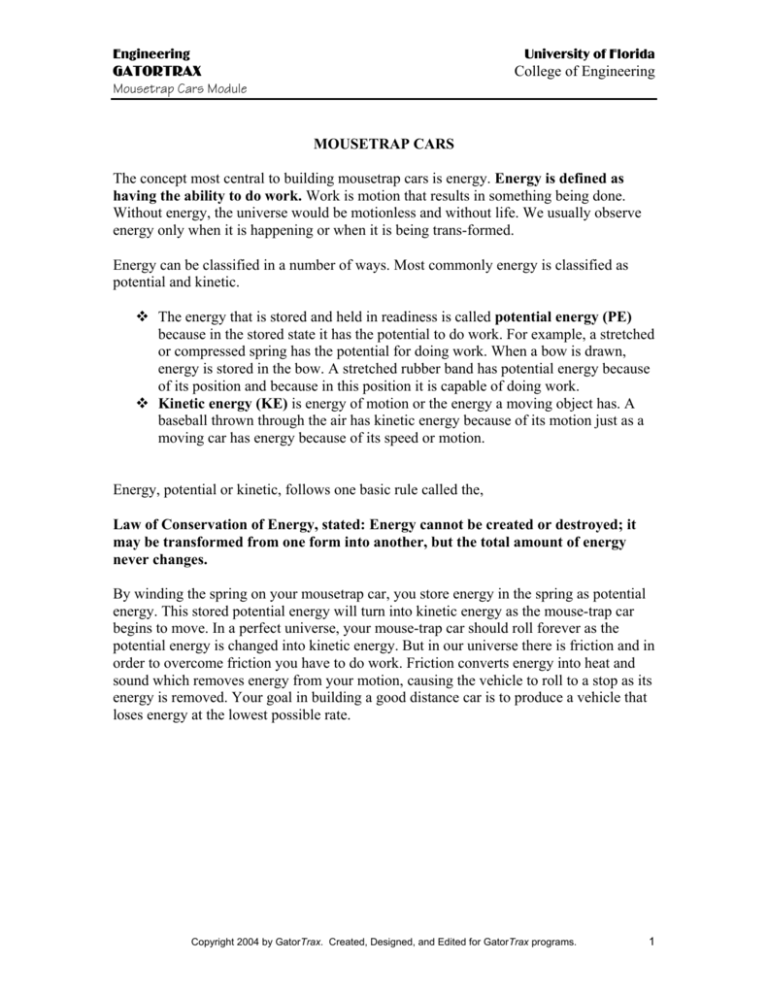
Engineering University of Florida GATORTRAX College of Engineering Mousetrap Cars Module MOUSETRAP CARS The concept most central to building mousetrap cars is energy. Energy is defined as having the ability to do work. Work is motion that results in something being done. Without energy, the universe would be motionless and without life. We usually observe energy only when it is happening or when it is being trans-formed. Energy can be classified in a number of ways. Most commonly energy is classified as potential and kinetic. The energy that is stored and held in readiness is called potential energy (PE) because in the stored state it has the potential to do work. For example, a stretched or compressed spring has the potential for doing work. When a bow is drawn, energy is stored in the bow. A stretched rubber band has potential energy because of its position and because in this position it is capable of doing work. Kinetic energy (KE) is energy of motion or the energy a moving object has. A baseball thrown through the air has kinetic energy because of its motion just as a moving car has energy because of its speed or motion. Energy, potential or kinetic, follows one basic rule called the, Law of Conservation of Energy, stated: Energy cannot be created or destroyed; it may be transformed from one form into another, but the total amount of energy never changes. By winding the spring on your mousetrap car, you store energy in the spring as potential energy. This stored potential energy will turn into kinetic energy as the mouse-trap car begins to move. In a perfect universe, your mouse-trap car should roll forever as the potential energy is changed into kinetic energy. But in our universe there is friction and in order to overcome friction you have to do work. Friction converts energy into heat and sound which removes energy from your motion, causing the vehicle to roll to a stop as its energy is removed. Your goal in building a good distance car is to produce a vehicle that loses energy at the lowest possible rate. Copyright 2004 by GatorTrax. Created, Designed, and Edited for GatorTrax programs. 1 Engineering University of Florida GATORTRAX College of Engineering Mousetrap Cars Module When designing a mousetrap powered car, there are two variables that truly determine the overall performance: friction and energy. Friction is what slows and stops your vehicle; energy is what moves your vehicle. If your vehicle encounters too much friction, your energy supply will be consumed too quickly and your vehicle will not travel very far or accelerate very fast. Evaluate every moving component on your vehicle and decrease the amount of friction at each point. As a general rule of thumb, the more moving components that a machine has, the greater the force of friction will be and the greater the energy consumption will be. Your ultimate goal when building a distance mouse-trap powered vehicle is to reduce friction to the lowest possible force. The smaller the frictional force, the farther your supply of energy will propel your vehicle. With this idea in mind, slow-moving vehicles will have a smaller force of air resistance acting against them and will travel farther than fastermoving vehicles. Copyright 2004 by GatorTrax. Created, Designed, and Edited for GatorTrax programs. 2 Engineering University of Florida GATORTRAX College of Engineering Mousetrap Cars Module The Mouse Trap Car (MTC) is going to travel a certain amount of distance (d) in a specific amount of time (t). To accomplish this, a lot of things will be taking place. Energy will have to be applied to generate a force, which in turn, will apply itself directly to the object causing the object to move in the direction in which the greater force is applied. Energy- The ability to due work; expressed in joules or Newton-meters (n-m). Energy is classified as the following: Potential Energy (P.E.) – stored energy due to position. P.E. = weight x height or P.E. = w x h Kinetic Energy (K.E.) – energy of motion. Derived from the Greek word kinein, Meaning, “to move.” K.E. = 1/2 mass x velocity or speed (squared) or K.E. – 1/2mv(squared) The velocity of the MTC is the measurement of how fast an object is moving in a specific direction. Velocity = distance/ time or d/t The MTC will begin from a position of rest (Potential Energy) and as the force is applied the energy in the MTC will change into Kinetic Energy. The importance of transferring energy from a potential state to a kinesthetic state is that once an object is moving it has the capacity to do work (force x distance). For example, we have been able to harness the moving energy of water and wind to generate electrical power that is used by many cities all over the world. The recent “Black out” in New York, Pennsylvania, Ohio, New Jersey, and Canada happened in energy storage and transfer equipment that handled the energy generated from the Niagara and St. Lawrence Rivers and Niagara Falls. These rivers and falls generate enough energy to provide service to over 50 million people! Force is the amount of push or pull on an object; measured in Newtons(N). Force = mass x acceleration or m x a After the force has been applied to the MTC, it begins to move in a direction (vector). As the force applied to the MTC gets it moving from rest to a maximum velocity. This change in velocity is called acceleration. Acceleration is the change in velocity per unit of time. Acceleration = (final velocity – initial velocity) / time Or A = v(final) - v(initial) T Copyright 2004 by GatorTrax. Created, Designed, and Edited for GatorTrax programs. 3 Engineering University of Florida GATORTRAX College of Engineering Mousetrap Cars Module Once the maximum velocity is reached constant external forces will eventually cause the MTC to slow down to a rest position (deceleration). Deceleration can be calculated the same way that we calculate acceleration. The external forces that are working against the car are the following: Friction Gravity Drag Wind (if applicable) Inertia (weight of the vehicle) Remember the Rocket Experiment. Ultimately, you are going to have a MTC that travels a certain amount of distance in a certain amount of time. Some cars will travel faster than others, while some will travel farther than others. There are a lot of external forces that you will have to overcome in order to get your MTC to achieve your desired goal. Analyzing your objective and understanding the constraints (resources, external forces, and the dynamics of your vehicle) will all come into play when you design your Mouse Trap Car. Newton’s Laws of Motion (and how they impact MTC): Newton’s First Law of Motion: Every object continues in its state of rest or in uniform motion in a straight line unless it is compelled to change that state by forces acting on it. Inertia is a fancy word meaning “resistance to change”. Inertia deals with the mass that the object has. It is the weight plus the force of gravity on a specific object. This is why you weigh more on earth than you would on the moon. The gravitational forces are less on the moon. Your MTC at rest has inertia. You most generate enough force to overcome the inertia of your MTC in order to get the car moving. Newton’s Second Law of Motion: The acceleration of an object is directly proportional to the net force acting on the object (in the direction of the net force) and inversely proportional to the mass of the object. In simple terms, mass resists change or acceleration (change in velocity), and force causes acceleration. If you want to triple the acceleration of an object, you have to triple the force. If you cannot increase the force and you still want to accelerate, then you have to remove mass. Example: Have you ever watched a show or a movie when someone is in a balloon, ship or spacecraft and they have to jettison (get rid of) extra ballast (objects) in order to go faster. Recently, in the movie “Master and Commander,” dealing with France and England competing for control of the Sea and their empire expansion. The French ship had recently damaged the British ship and was closing in for the kill. The Commander of the British vessel instructed his crewmen to throw all non essential equipment and Copyright 2004 by GatorTrax. Created, Designed, and Edited for GatorTrax programs. 4 Engineering University of Florida GATORTRAX College of Engineering Mousetrap Cars Module supplies of the ship to lighten the load, which enabled the ship to move faster (accelerate) and escape the quickly approaching French warship. Force = mass x acceleration You will have to take into account the mass of your MTC and your ability to generate enough energy to create a great enough force allowing you to achieve maximum acceleration. Newton’s Third Law of Motion: Whenever one object exerts a force on a second object, the second object exerts an equal and opposite force on the first. For every action there is an equal and opposite reaction. Here is where we look at” push and pull”. Newton recognized that a force is actually the interaction between two objects. For example, if you push against a brick wall, the brick wall is actually pushing back on you! You and the brick wall are an interaction pair, you apply a force to the wall, and the wall applies a force back. The evidence of this is in your bent fingers. You sit on a chair and you exert a force on the chair since you do not fall, the chair is exerting a force against you. A MTC car is propelled because the drive wheels push on the floor and the floor pushes back on the car causing the MTC to move or accelerate. A vehicle’s acceleration is limited by the interaction between the wheels and the floor. A “speed car” or any vehicle that produces a lot of torque, the wheels can only push as hard as the vehicle can push back. Therefore, if the floor can not push back with the same force as the wheels push, then the wheels spin in place and the car will not accelerate to its maximum velocity. (Hint: increase traction (friction) between the two surfaces). A final note on Newton: Remember mass is resistant to change. The more massive your vehicle the more energy and force you will need to start your vehicle moving, compared to smaller and lighter vehicles. On the other hand, if your vehicle is too light, you will not have enough friction to start your vehicle moving. Only through experimentation will you find your target mass. And do not forget to consider the impact of your lever arm. EVALUATION Copyright 2004 by GatorTrax. Created, Designed, and Edited for GatorTrax programs. 5 Engineering University of Florida GATORTRAX College of Engineering Mousetrap Cars Module Performance of the Mousetrap Vehicles will not be evaluated at this time. Although the focus of this GatorTRAX activity is on the concepts of energy and motion, which can be applied in a wide variety of instances, SECME students will find this foundation to be valuable in the SECME Mousetrap Competition. Two formulas are used to calculate the Performance score for the car run: ⎛ w ⎞ ⎛D⎞ N = ⎜ ⎟X ⎜ ⎟ ⎝W ⎠ ⎝ L ⎠ 2 and F= N X 100 NL where: N....is the score. To ensure that cars actually perform and not just be small and light, N=0 if D is LESS than 300 centimeters (for middle school/junior high teams) N=0 if D is LESS than 600 centimeters (for high school teams) w....is the mass of the original mousetrap (always taken as 25 grams). NOTE: At all competitions, this standard value will be used in calculating the Performance score. W....is the total mass of the completed car in grams. D....is distance measured in a straight line from the starting point to the stopping point in centimeters. D=2,500 if the car travels 2,500 centimeters or more. L....is the car’s longest dimension in any direction (not necessarily the length) in centimeters, measured with the bail extended or retracted, whichever is greater.* NL...is the highest Performance score at the competition site F....is the final Performance score (to be combined with scores for the Design Drawing, Technical Report, and Team Interview). Overall Team Score in competition is sum of: 1) Performance (car run) as calculated above (max. 100 points); 2) Design Drawing (max. 50 points); 3) Technical Report (max. 50 points); and 4) Team Interview (max. 50 points). Thus the maximum total is 250 points. Copyright 2004 by GatorTrax. Created, Designed, and Edited for GatorTrax programs. 6 Engineering University of Florida GATORTRAX College of Engineering Mousetrap Cars Module Mouse Trap Math Bail Spring Mousetrap wood Wheels Basic Math: Diameter (D) = 2 x R Circumference (C) = πd Radius (R)= ½ d In mousetrap terms: Radius = length of bail Or = length from center of wheel to rim One wheel turn = circumference Copyright 2004 by GatorTrax. Created, Designed, and Edited for GatorTrax programs. 7 Engineering University of Florida GATORTRAX College of Engineering Mousetrap Cars Module Initial Rotation The changes in distance of the bail from initial point A Æ B. Figure 1 Path of Bail B R A Thus, distance change of a string from point AÆ B is simply the diameter of the circle shown. Find the length the string is pulled if the bail is: A) 2 in. __________ B) 4.2 cm __________ C) 3.11 mm __________ D) 5.2 cm __________ How does the length of the bail affect the distance a mousetrap car runs? Copyright 2004 by GatorTrax. Created, Designed, and Edited for GatorTrax programs. 8 Engineering University of Florida GATORTRAX College of Engineering Mousetrap Cars Module How far will the Mousetrap go? What is the change of bail distance from A Æ B? What is the diameter of the axle connected to string? What is the diameter of the wheel connected to the axle? __________ (2 x R) __________ (d1) __________ (d2) The approximate distance (M) the mousetrap will go is found using the following equation: M=(d2/d1) x 2 x R Calculate your M with the materials given. Copyright 2004 by GatorTrax. Created, Designed, and Edited for GatorTrax programs. 9 Engineering University of Florida GATORTRAX College of Engineering Mousetrap Cars Module Amplifying Mousetrap distance Figure 2 R2 R1 Gears allow for either an increase of decrease in the amount of rotations onto another gear. The rate (speed) at which gears rotate is given as angular rotation (ω). To determine the amplification we use a ratio as shown Circumference1 x ω1 : Circumference2 x ω2 πD1ω1 : πD2ω2 Gears have the same rotation, thereforeÆ ω1 = ω2 2πR1ω1 : 2πR2ω2 R1 : R2 or D1 : D2 Find the ratios of the following gears if: R1 = 10 mm R2 = 5mm Ratio _____:_____ R1 = .3 in R2 = .1 in Ratio _____:_____ R1 = 75 mm R2 = 5 mm Ratio _____:_____ R1 = 12 mm R2 = 2 mm Ratio _____:_____ R1 = 3 ft R2 = 6 in Ratio _____:_____ R1 = 1.12 in R2 = .08 in Ratio _____:_____ Copyright 2004 by GatorTrax. Created, Designed, and Edited for GatorTrax programs. 10 Engineering University of Florida GATORTRAX College of Engineering Mousetrap Cars Module Transferring the velocity of gears There is one simple rule; the rotation of one gear is proportional to the ratio of gear size of one gear to another. Figure 3 Rotation 2 (ω2) Rotation 1 (ω1) Connection to bail R3 R1 R4 R2 Let’s look at the piece-by-piece portions of a gear. If the driving force is connected to the smaller radius and is connected to the same shaft/axel to a larger radius gear/wheel, the rotation distance is amplified. If the driving force is transferred from the bigger wheel to the smaller wheel, then the rotational distances are equal. C =2πRbig = 2πRsmall Copyright 2004 by GatorTrax. Created, Designed, and Edited for GatorTrax programs. 11 Engineering University of Florida GATORTRAX College of Engineering Mousetrap Cars Module FIGURE 3.1 L1 x (R2 / 1 R1) 2 X (R4 3 / R3) X (Rw 4 / 5 Rend) 6 From the figure above, the mousetrap starts and rotates the length of the movement of the mousetrap bail L1. So the change in distance of the bail is equal to the movement of R1. R1 is amplified to R2 The distance R2 moves equals the distance of R3 The distance of R3 is amplified to R4 The distance R4 moves equals to the distance of R5 R5 is amplified to the radius of the wheels. If you use the following values, what is the final distance? Length of bail is 4 in. R1 = .1 in, R2 = .5in, R3 = .2 in, R4 = .6in, R5 = .1 in wheel radius = 2 in Final Distance? Hint: Find the change of bail distance first and work your way through. Copyright 2004 by GatorTrax. Created, Designed, and Edited for GatorTrax programs. 12

